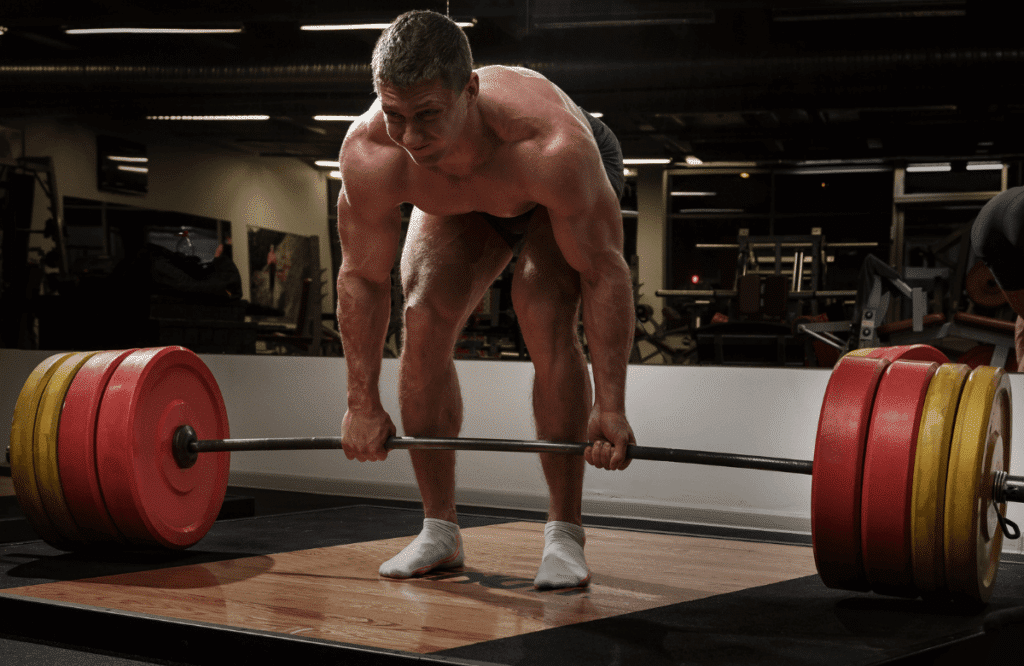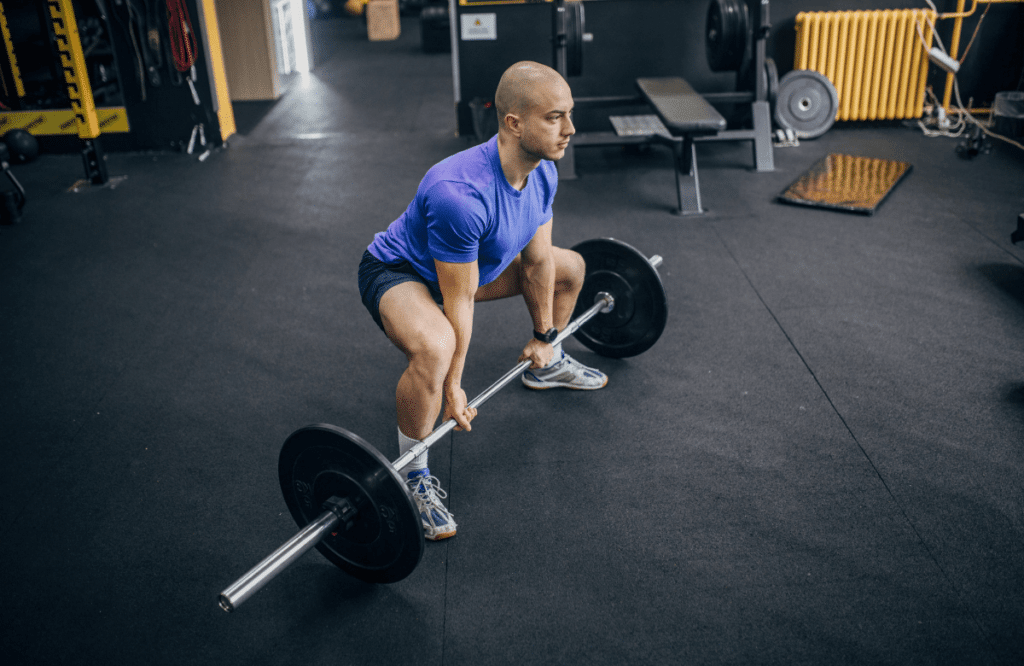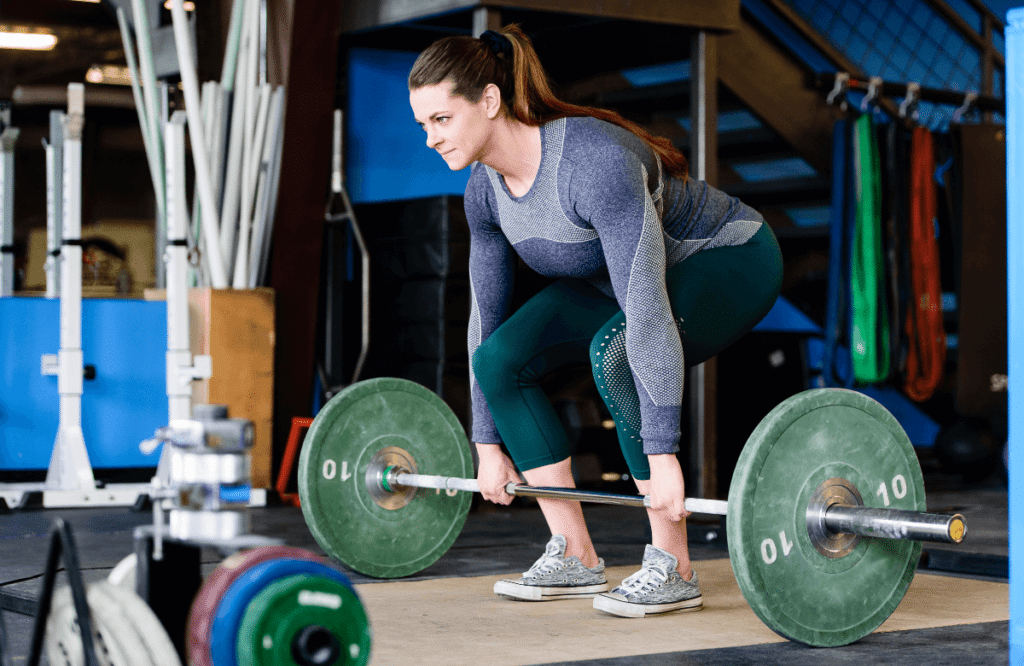Ah, the humble deadlift. One of the main compound movements and a cornerstone of strength. We all dream of having a strong deadlift, but how do you break through plateaus and progress your lift?
In this article, we’ll cover how to increase your deadlift, the common causes of plateaus, and what you can do to build deadlift strength.
Jump to:
What Is a Deadlift Plateau?
A deadlift plateau indicates a situation where a weightlifter can’t increase their deadlift max despite consistent training sessions.
Although it’s unlikely to happen to novice lifters, plateaus can happen to anyone, including advanced and intermediate lifters.
It’s a common and frustrating situation. When you hit a plateau, you may need to adjust your training program, incorporate different movements, or address technique flaws to continue making progress.
What Are the Common Causes of Plateaus?
So, you want a stronger deadlift but can’t seem to get past your one rep max—what gives?
Plateaus can happen for various reasons, including inadequate recovery time, poor form, or overtraining. Let’s take a look at these aspects in more detail.
Poor Deadlift Form and Technique
Your deadlift technique can make or break your progress after a certain point. It’s possible to skate without proper form, but not for long.
The wrong technique will recruit muscles less effectively and increase the chances of injury, making it challenging to lift heavier weights. It isn’t possible to achieve the perfect technique, but you can surely reach an optimal technique.
This may include adjusting your starting position or grip method and focusing on a mind-to-muscle connection.
Lack of Training Variety
If you’re only executing the conventional deadlift, you may stunt your progress over time. The traditional deadlift is a compound lift, meaning it targets several muscle groups—the hamstrings, glutes, core, back, and other secondary movers.
Without accessory exercises, you run the risk of developing weak points in your deadlift movement. Incorporating deadlift variations into your strength training routine are also essential, as they can help you target specific weak points.
Adding variety to your training week may also include adjusting the training volume, rep ranges, and time under tension.

Over or Undertraining
Over and undertraining are other common culprits behind deadlift plateaus. If you’re not engaging the deadlift muscles enough each training week, you won’t build as much muscle mass.
On the flip side, if you’re overdoing the classic deadlift, you run the risk of burnout and injury.
There’s a sweet spot between over and undertraining. Only you can know how hard to push your body and when to call it quits. If you’re only training deadlifts 1-2 times per week, you probably need to increase the volume.
But if you have the biggest deadlift in your gym and don’t take enough rest days, it may be time to reduce your training volume.
Nutrition and Recovery
Proper nutrition and recovery are critical for lifting heavy weights. Your body needs the right resources to develop deadlift strength, and without them, you’re likely to hit a plateau. Improper nutrition can be as simple as not eating enough before the gym.
Carbohydrates are essential for providing the energy needed to perform heavy lifts. Without enough carbohydrates, you may struggle to complete your training sets.
Protein is also critical for muscle repair and growth. Your muscles may not have the necessary building blocks to recover and grow without adequate protein intake.
Sleep is another overlooked element that’s crucial for building deadlift strength. During sleep, the body repairs damaged muscle tissue and release growth hormones. Without enough sleep, you may struggle to recover correctly and find it challenging to build deadlift strength.
Mental Barriers
Although the previous causes are more common for deadlift plateaus, mental barriers can also significantly impact your ability to build deadlift strength. In some cases, mental barriers can be as challenging or even more challenging than physical limitations.
Mental barriers can vary greatly and may take the form of negative self-talk, low confidence, fear, or inconsistency.
For example, you may tell yourself you can’t lift a certain deadlift weight, becoming less motivated and putting less effort into your session. Or you may be scared of heavy deadlifts because of injury or failure.
Either way, these issues can be pervasive and affect your progress. To overcome mental barriers, you may need to focus on developing a positive mindset, visualizing success, and setting achievable goals.

Solutions to Increase Your Barbell Deadlift Strength
Now that you understand some of the common causes of plateaus, how do you address these issues and build raw strength?
Determine the Root Cause
If you’re an advanced lifter, you may be able to spot the cause of your plateau, like over or undertraining. This will help you develop a strategy for increasing your deadlift strength.
But if you’re a new lifter or lack training experience, you may not know which issue is most important to handle first. Although tackling all of the elements is sure to improve your lift, it’s better to address the most pressing factor first.
Here are a few questions to ask yourself to help determine the root cause of your deadlift plateau:
- Have I been progressively increasing the weight I lift?
- Have I been consistently training with good form?
- Do I have any underlying weaknesses or imbalances?
- Am I getting enough sleep to support muscle recovery?
- Am I eating enough protein and carbohydrates to fuel my workouts?
- Am I experiencing any pain or discomfort during or after my deadlifts?
These questions can help identify areas that may be contributing to a deadlift plateau, allowing you to take steps to address the underlying issue and continue making progress.
Identify Weak Points in Your Form
One of the most critical steps in increasing your deadlift strength is to identify any weak points in your form. The deadlift is a complex movement that uses multiple muscle groups, making it easy to have weaknesses.
Proper form is essential for both performance and injury prevention. If you’re an advanced lifter, you may have bad habits, underlying weaknesses, or imbalances that need to be addressed.
Depending on the weak point, you may include accessory lifts or deadlift variations to address the significant muscles.
If you miss the lift at the midpoint, you may add block, pause, or Romanian deadlifts to your deadlift workout routine. If you have difficulties at the bottom of the lift, you may incorporate deficit deadlifts, box squats, or pendlay rows.
Incorporate Accessory Movements
Identifying your weak points will help you determine the right accessory movements for your training regimen. Deadlift accessory exercises will help you isolate and strengthen the different muscle groups in the movement.
Some deadlift accessory exercises include the following:
- Romanian deadlift
- Barbell rows
- Pause deadlifts
- Deficit deadlifts
- Rack pulls
- Hamstring curls
- Trap bar deadlifts
- Hip thrusts
- Front squats
Adjust Your Volume or Intensity
To develop a strong deadlift, you need to have an adequate training protocol. In most cases, you’re probably not training enough. The more you train, the more likely you are to build muscle mass and improve your technique.
It’s recommended to train deadlift at least three times per week, as long as you’re getting enough rest.
Your workout intensity will vary, but you should be lifting heavy loads to develop strength. This means lifting weights in the 4-6 rep range. You can adjust the training intensity depending on your situation, like lifting lighter weights for 10-12 reps.

Don’t Forget Rest Days
Don’t forget to take rest days. Rest and recovery are essential for allowing your muscles to repair and grow stronger. Overtraining can lead to fatigue, injury, and hindered progress.
If you’re lifting heavy deadlifts, you may need to take a rest day between each training session. For example, you might do deadlifts Mon/Wed/Fri and take Tuesday, Thursday, and the weekend off.
The amount of rest you need will also depend on your circumstances. If you have a demanding or stressful job, you may need to adjust your training program. It’s best to aim for 7–9 hours of high-quality sleep.
Mobility work can also help improve recovery by promoting flexibility and range of motion. Tight muscles and joints can impair deadlift performance and increase the risk of injury, so incorporating mobility work into your routine can be beneficial for plateaus.
Change Your Stance or Grip
Sometimes, a small change to your starting stance or grip can dramatically improve your deadlift strength.
You might consider switching to a sumo deadlift technique, which uses a wider stance. This variation can target the legs and hips more, alongside reducing the range of motion.
Switching to a different grip can also be beneficial for enhancing grip strength. You might swap to a hook grip or an overhand grip to pull heavier loads off the ground. These small changes can go a long way, depending on your training experience.

Frequently Asked Questions (FAQ)
How Can I Increase My Deadlift Fast?
Building a solid deadlift will take time, but training three times a week with an effective training program will go a long way. Be sure you’re eating enough protein, progressively increasing weight, getting enough rest, and practicing proper technique.
How to Add 100 Lbs to Deadlift?
To add 100 lbs to your deadlift, you’ll need to progressively increase the weight and eat enough calories. Depending on your training experience, you may be able to add 100 lbs to the bar in 1–3 months. Focusing on your weak points, adding variations, and practicing proper technique will go a long way.















